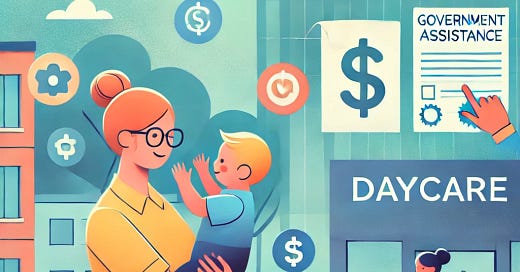Creating Welfare that Works: New Data on the Child Tax Credit and Work Incentives
New research shows that the pandemic-era Child Tax Credit did not affect employment or labor force participation. However, worker behavior may differ for more permanent childcare programs.

Today’s guest post is by Susannah Barnes-Petitt, a graduate student in economics at George Mason University, and the Program Manager for both Labor Policy and Fiscal Studies at the Mercatus Center.
The question of how and whether to support parents through child care subsidies or tax credits is emerging as a key policy issue. Both Presidential candidates have supported expanding the pandemic-era Child Tax Credit in hopes of reducing child poverty and making it easier for families to balance the demands of raising a child and working. While details on expanding the Credit vary between the candidates, both would like to make the American Rescue Plan’s expansion of the Child Tax Credit permanent as a starting point.
The expansion under the American Rescue plan gave most households with children up to $300 per child under 6 and $250 per child between 6 and 17. The first payment in July of 2021 was allocated to approximately 59 million children, while later payments were distributed to over 61 million children. The expansion lasted for five months, before ending in December 2021. Assessments of the program’s efficacy are mixed – proponents of the expansion argue that the expanded credit reduced food insufficiency and child poverty, while critics of the expansion argue that the program could create dependency on welfare for the lowest income groups by reducing the incentive to work.
New research published in the Journal of Public Economics by Elizabeth Ananat, Benjamin Glasner, Christal Hamilton, Zachary Parolin and Clemente Pignatti looks at the latter claim and seeks to test the employment effects of the expansion under the American Rescue Plan. The authors did not find that the expanded credit had a statistically significant and robust impact on employment or hours worked.
Regardless of household income, size of payments, or changes in work arrangements, the 2021 child tax credit expansion did not appear to affect employment or labor force participation.
These results are a good thing for those concerned about reduced employment following the expansion, especially because the lowest income groups who gained the most from the expansion and whose labor supply is likely more elastic did not see significant changes in employment. However, as the authors point out, these results may be driven by the temporary nature of the expansion or as a result of the labor market conditions of the time.
No Employment Effects is a Mixed Bag
It is worth noting that “no employment effects” can be both positive and negative. If you are concerned about disincentives to work, seeing no employment effects is a good thing. But if you are interested in welfare programs that can boost employment, seeing no effect is worrisome.
Creating attachments to the labor force and having parents who work is one of the most effective ways to improve social mobility. A study by the Center for Poverty and Inequality Research at UC Davis found that employment for 30 weeks out of the year instead of 20 is associated with a 16 percent higher chance that someone will rise above the poverty line and lowers the chances of reentering poverty by one third. Our current welfare system is not designed to boost social mobility. While child poverty has declined over the past several decades, social mobility has stagnated. Many children are no better off than their parents.
The most effective welfare programs would help families balance work and demands of raising children. This also means protecting the flexible and diverse forms of work, including non-traditional work arrangements like self-employment, freelancing, and gig work.
Behavior Differs for Temporary and Permanent Programs
The recent data seems to suggest that the pandemic-era Child Tax Credit was an effective tool to help families during times of need.
But extrapolating the data from a temporary expansion during times of economic distress to present day may create poorly crafted policy. Behavior in the short-run and the long-run differs. When given cash transfers without an end date families may act differently than they did during a temporary expansion. The end date on the expansion may have served as a warning against drastic changes in behavior like limiting hours worked or quitting jobs. It may be a different story during a permanent expansion, especially for those receiving other forms of government assistance.
Indeed, some research does indicate that in countries where welfare programs for women and children are expansive (like Scandinavian countries), women work fewer hours and experience greater gender gaps in earnings. This result is especially pronounced for mothers, who experience “motherhood penalties” that reduce their participation in the labor force and their hours worked.




